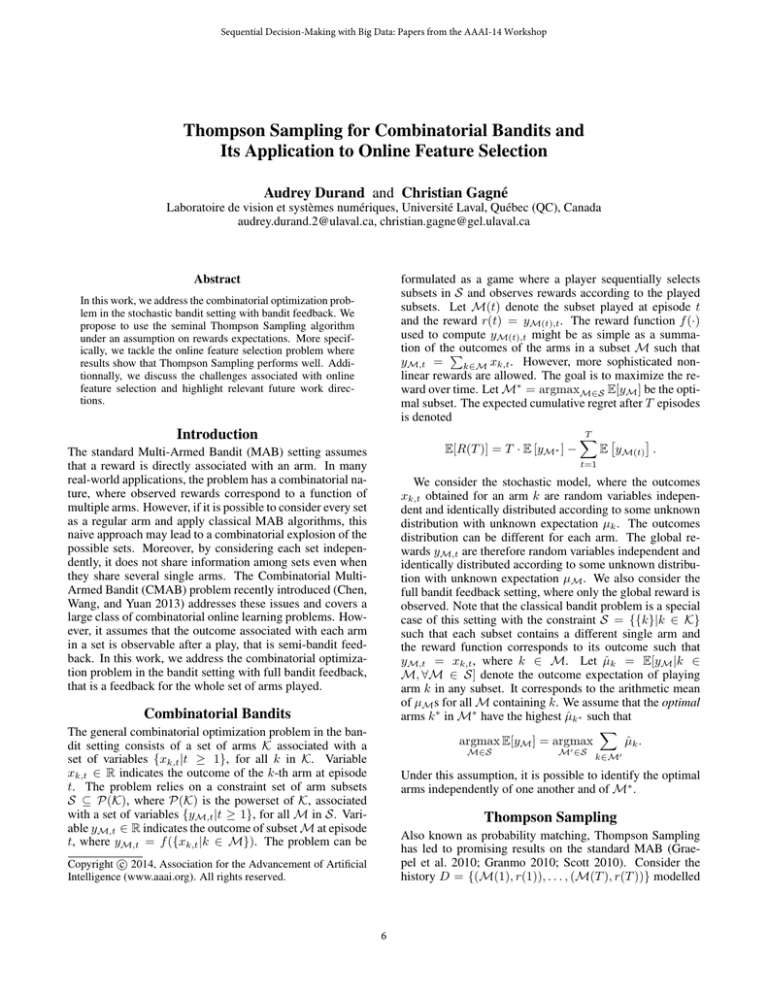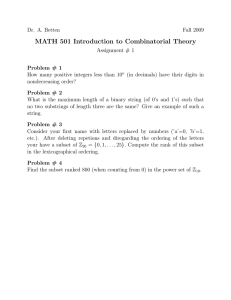
Sequential Decision-Making with Big Data: Papers from the AAAI-14 Workshop
Thompson Sampling for Combinatorial Bandits and
Its Application to Online Feature Selection
Audrey Durand and Christian Gagné
Laboratoire de vision et systèmes numériques, Université Laval, Québec (QC), Canada
audrey.durand.2@ulaval.ca, christian.gagne@gel.ulaval.ca
formulated as a game where a player sequentially selects
subsets in S and observes rewards according to the played
subsets. Let M(t) denote the subset played at episode t
and the reward r(t) = yM(t),t . The reward function f (·)
used to compute yM(t),t might be as simple as a summation of thePoutcomes of the arms in a subset M such that
yM,t =
k∈M xk,t . However, more sophisticated nonlinear rewards are allowed. The goal is to maximize the reward over time. Let M∗ = argmaxM∈S E[yM ] be the optimal subset. The expected cumulative regret after T episodes
is denoted
Abstract
In this work, we address the combinatorial optimization problem in the stochastic bandit setting with bandit feedback. We
propose to use the seminal Thompson Sampling algorithm
under an assumption on rewards expectations. More specifically, we tackle the online feature selection problem where
results show that Thompson Sampling performs well. Additionnally, we discuss the challenges associated with online
feature selection and highlight relevant future work directions.
Introduction
E[R(T )] = T · E [yM∗ ] −
The standard Multi-Armed Bandit (MAB) setting assumes
that a reward is directly associated with an arm. In many
real-world applications, the problem has a combinatorial nature, where observed rewards correspond to a function of
multiple arms. However, if it is possible to consider every set
as a regular arm and apply classical MAB algorithms, this
naive approach may lead to a combinatorial explosion of the
possible sets. Moreover, by considering each set independently, it does not share information among sets even when
they share several single arms. The Combinatorial MultiArmed Bandit (CMAB) problem recently introduced (Chen,
Wang, and Yuan 2013) addresses these issues and covers a
large class of combinatorial online learning problems. However, it assumes that the outcome associated with each arm
in a set is observable after a play, that is semi-bandit feedback. In this work, we address the combinatorial optimization problem in the bandit setting with full bandit feedback,
that is a feedback for the whole set of arms played.
T
X
E yM(t) .
t=1
We consider the stochastic model, where the outcomes
xk,t obtained for an arm k are random variables independent and identically distributed according to some unknown
distribution with unknown expectation µk . The outcomes
distribution can be different for each arm. The global rewards yM,t are therefore random variables independent and
identically distributed according to some unknown distribution with unknown expectation µM . We also consider the
full bandit feedback setting, where only the global reward is
observed. Note that the classical bandit problem is a special
case of this setting with the constraint S = {{k}|k ∈ K}
such that each subset contains a different single arm and
the reward function corresponds to its outcome such that
yM,t = xk,t , where k ∈ M. Let µ̂k = E[yM |k ∈
M, ∀M ∈ S] denote the outcome expectation of playing
arm k in any subset. It corresponds to the arithmetic mean
of µM s for all M containing k. We assume that the optimal
arms k ∗ in M∗ have the highest µ̂k∗ such that
X
argmax E[yM ] = argmax
µ̂k .
Combinatorial Bandits
The general combinatorial optimization problem in the bandit setting consists of a set of arms K associated with a
set of variables {xk,t |t ≥ 1}, for all k in K. Variable
xk,t ∈ R indicates the outcome of the k-th arm at episode
t. The problem relies on a constraint set of arm subsets
S ⊆ P(K), where P(K) is the powerset of K, associated
with a set of variables {yM,t |t ≥ 1}, for all M in S. Variable yM,t ∈ R indicates the outcome of subset M at episode
t, where yM,t = f ({xk,t |k ∈ M}). The problem can be
M∈S
M0 ∈S
k∈M0
Under this assumption, it is possible to identify the optimal
arms independently of one another and of M∗ .
Thompson Sampling
Also known as probability matching, Thompson Sampling
has led to promising results on the standard MAB (Graepel et al. 2010; Granmo 2010; Scott 2010). Consider the
history D = {(M(1), r(1)), . . . , (M(T ), r(T ))} modelled
c 2014, Association for the Advancement of Artificial
Copyright Intelligence (www.aaai.org). All rights reserved.
6
Algorithm 1 Thompson Sampling with Bernoulli likelihood
for combinatorial optimization problem
1: assume α0 and β0 the priors of the Beta distribution
2: for each arm k, maintain nk (t) as the number of times
arm k has been played so far and rk (t) as the cumulative
reward associated with arm k
3: t = 0
4: loop
5:
t=t+1
6:
for all arms k in K do
7:
αk (t) = α0 + rk (t)
8:
βk (t) = β0 + nk (t) − rk (t)
9:
sample θk ∼ Beta(αk (t), βk (t))
10:
end for
P
11:
play M(t) = argmaxM∈S k∈M θk
12:
observe r(t)
13:
update nk (t + 1) and rk (t + 1) for k ∈ M(t)
14: end loop
Algorithm 2 Online feature selection as a combinatorial optimization problem in the bandit setting
1: let M denote the subset size
2: t = 0
3: loop
4:
t=t+1
5:
select the subset M(t) of features
6:
receive data vt , perceiving only the features in M(t)
7:
make prediction p using vt
8:
receive real class c
9:
r(t) = H(p · c)
10:
update classifier using vt
11:
update feature selection heuristic using r(t)
12: end loop
and all the features of training instances are given a priori.
Such assumptions may not always hold for real-world applications in which data arrive sequentially and collecting full
information data is expensive, which are particularly common in the context of learning with Big Data.
The current work considers the online feature selection
problem using partial inputs (Wang et al. 2014). In this
challenging scenario, the learner is only allowed to access
a fixed small number of features for each training instance.
The problem is therefore to decide which subset of features
to observe in order to maximize the classification rate. The
online feature selection problem must be distinguished from
the online streaming feature selection problem (Wu et al.
2013), where all the training instances are available at the
beginning of the learning process and their features arrive
one at a time. This differs significantly from our online
learning setting where instances arrive sequentially. Moreover, the partial inputs constraint prevents using budget online learning and online PCA algorithms as they require full
inputs.
We model the online feature selection problem as a combinatorial optimization problem in the bandit setting, where
each feature corresponds to an arm. On each episode t, the
algorithm selects a subset M(t) of features to observe on
the arriving data. The data is classified using its observable features and a reward is obtained according to success
(r(t) = 1) or failure (r(t) = 0). The whole process is described by Algorithm 2, where H(·) is the Heaviside step
function, that is H(x) = 1 iff x ≥ 0, and H(x) = 0 otherwise.
Wang et al. (2014) introduced the OFS approach to tackle
the online feature selection problem. Given by Algorithm 3,
OFS for partial inputs uses a perceptron classifier with
sparse weights along with an ε-greedy heuristic for feature subset selection, where the truncation process consists
in keeping only the M (absolute) largest weights. In this
work, we consider the general online feature selection problem where one is not limited to sparse classifiers. The εgreedy heuristic considered in OFS for partial inputs cannot
be used directly with other classifiers as it is tightly coupled
with the weights of OFS. Algorithm 4 describes ε-greedy
with a non-sparse classic perceptron, where the greedy sub-
using a parametric likelihood function P (r|k ∈ M, θ) depending on some parameters θ. Given some prior distribution P (θ) on the parameters, their posterior distribution is
QT
given by P (θ|D) ∝ t=1 P (r(t)|k ∈ M(t), θ)P (θ). The
Thompson Sampling heuristic selects the arms of the next
subset according to their probability of being optimal. That
is, arm k is chosen with probability
Z 0
E(r|k , θ) P (θ|D)P (θ)dθ,
I E(r|k, θ) = max
0
k
where I is the indicator function. A standard approach is
to model the expected outcome µ̂k of each arm using θ parameters. Instead of computing the integral, a θk is sampled
for each arm k. In the combinatorial optimization problem,
Thompson Sampling selects the M arms maximizing θk .
Suppose that the rewards follow a Bernoulli distribution.
Let nk (T ) denote the number of times that arm k has been
pulled up to episode T and
rk (T ) =
T
X
I[k ∈ M(t)]r(t)
t=1
represent the cumulative reward associated with arm k up
to episode T . The conjugate prior distribution is therefore a
Beta with priors α0 and β0 such that
θk ∼ Beta(αk , βk ),
where αk (t) = α0 + rk (t) and βk (t) = β0 + nk (t) − rk (t).
The corresponding Thompson Sampling with Bernoulli likelihood for the combinatorial optimization problem is described by Algorithm 1.
Online Feature Selection
It is often desirable to select a subset of the original features in order to reduce processing complexity and noise,
to remove irrelevant data, or because observing every feature might be too expensive. Most existing studies of feature selection are restricted to batch learning, where the feature selection task is conducted in an offline learning fashion
7
Algorithm 3 OFS for partial inputs (Wang et al. 2014)
1: let K denote the total number of features; M the subset size; λ the maximum L2 norm; ε the explorationexploitation trade-off; and η the step size
2: w1 = 0K
3: t = 0
4: loop
5:
t=t+1
6:
sample z ∼ Bernoulli(ε)
7:
if z = 1 then
8:
randomly select a subset M(t) of features
9:
else
10:
select features associated with non-null weights in
wt such that M(t) = {k : [wt ]k 6= 0}
11:
end if
12:
receive data vt , perceiving only the features in M(t)
13:
make prediction p = wt> vt
14:
receive real class c
15:
if p · c ≤ 0 then
16:
compute vt0 where [vt0 ]k = M ε+I([w[v]t ]k6=0)(1−ε)
0
wt+1
= wt0 +ηcvt0
17:
0
wt+1
= min 1, ||w0λ
K
Algorithm 4 Perceptron with ε-greedy
1: let K denote the total number of features; M the subset
size; ε the exploration-exploitation trade-off; and η the
step size
2: w1 = 0K
3: t = 0
4: loop
5:
t=t+1
6:
sample z ∼ Bernoulli(ε)
7:
if z = 1 then
8:
randomly select a subset M(t) of features
9:
else
10:
select features maximizing the absolute
P weights in
wt such that M(t) = argmaxM∈S k∈M |[wt ]k |
11:
end if
12:
receive data vt , perceiving only the features in M(t)
13:
make prediction p = wt> vt
14:
p = 2H(p) − 1
15:
receive real class c
16:
if p · c < 0 then
0
17:
wt+1
= wt + ηcvt
0
18:
wt+1 = truncate(wt+1
, M)
19:
else
20:
wt+1 = wt
21:
end if
22: end loop
t k
0
wt+1
t+1 ||2
0
truncate(wt+1
, M)
18:
19:
wt+1 =
20:
else
21:
wt+1 = wt
22:
end if
23: end loop
Table 1: Datasets characteristics
Dataset
# samples # features
Covertype (binary)
581 012
54
Spambase
4601
57
Adult (a8a)
32 561
123
Web Linear (w8a)
64 700
300
set now corresponds to the features maximizing the absolute
weights in the perceptron.
The performance of algorithms corresponds to their online rate of mistakes given by
ORM(T ) =
number of mistakes
,
T
We compare the online feature selection as a combinatorial optimization problem in bandit setting described by
Algorithm 2, using:
where T corresponds to the number of episodes, that is the
total number of data received up to that point. As explained
previously, data samples are processed sequentially. For
each sample, the heuristic selects the feature subset to perceive. The classifier then predicts the class of the sample
using only these features, before receiving the label and updating its weights. As there is no training/testing phase, the
performance is computed on the entire datasets. Note that
the ORM cannot be compared with the offline classification
error rate commonly used for offline algorithms as it cumulates errors along the whole learning process.
• a multilayer perceptron (MLP) (K inputs and one hidden layer of 2 neurons) using Thompson Sampling for
Bernoulli likelihood, as given by Algorithm 1, for subset
feature selection;
• OFS for partial inputs, as given by Algorithm 3;
• a perceptron using ε-greedy for subset feature selection,
as given by Algorithm 4.
The MLP with full feature observation (no subset selection)
is used as baseline for comparison.
We configure the experimental setting as in Wang et al.
and select M = b0.1 × dimensionality + 0.5c features for
making the subsets for every dataset. All classifiers share the
same parameter η = 0.2. For the OFS algorithm, λ = 0.1.
Prior parameters α0 = 1 and β0 = 1 are used for Thompson
Sampling. For ε-greedy feature selection, experiments were
conducted with ε ∈ {0.05, 0.2, 0.5}, but only the best results
are reported. The experiments were repeated 20 times, each
with a random permutation of the dataset, and the results
Experimental Setting
Experiments are conducted on the benchmark datasets described in Table 1, which have been standardized relatively
to their mean and standard deviation. These datasets are all
available either on the UCI machine learning repository1 or
the LIBSVM website2 .
1
2
http://archive.ics.uci.edu/ml/index.html
http://www.csie.ntu.edu.tw/∼cjlin/libsvmtools/datasets/
8
Online average rate of mistakes
reported are averaged over these runs.
Results
Figure 1 shows the evolution of the average rate of classification errors on the different datasets. We observe that using
Thompson Sampling for feature subset selection combined
with a MLP either minimizes the cumulative error rate or
leads to a faster convergence. It even outperforms the MLP
that observes all features on Adult and Web Linear datasets.
Challenges and Future Work
In the online setting, data arrive sequentially and are only
partially observable. A first challenge consists in designing classifiers that are robust to this situation. Moreover,
since the whole dataset is not available for data normalization or standardization, preprocessing techniques should
rely on prior knowledge or assumptions on the data. Online
preprocessing techniques as in Zliobaite and Gabrys (2014)
should therefore be considered to provide a realistic setup
for a real-world application.
Measuring the long-term performance in the online setting is another challenge. Unlike offline algorithms, online
heuristics carry out the tradeoff between exploration and exploitation forever. It is difficult to compare the online feature selection algorithms with their offline counterparts, for
which performance is measured in exploitation only.
1.0
OFS + ε -greedy (ε : 0.2)
Perceptron + ε -greedy (ε : 0.2)
MLP + Thompson Sampling
MLP All features
0.8
0.6
0.4
0.2
0.0
101
102
103
104
Number of samples
105
106
Online average rate of mistakes
(a) Covertype
1.0
OFS + ε -greedy (ε : 0.2)
Perceptron + ε -greedy (ε : 0.2)
MLP + Thompson Sampling
MLP All features
0.8
0.6
0.4
0.2
0.0
101
103
102
Number of samples
104
(b) Spambase
Online average rate of mistakes
Acknowledgements This work was supported through
funding from FRQNT (Québec) and NSERC (Canada).
References
Chen, W.; Wang, Y.; and Yuan, Y. 2013. Combinatorial
multi-armed bandit: General framework and applications.
In Proceedings of the 30th International Conference on Machine Learning (ICML), 151–159.
Graepel, T.; Candela, J. Q.; Borchert, T.; and Herbrich, R.
2010. Web-scale Bayesian click-through rate prediction for
sponsored search advertising in Microsoft’s Bing search engine. In Proceedings of the 27th International Conference
on Machine Learning (ICML), 13–20.
Granmo, O.-C. 2010. Solving two-armed Bernoulli bandit problems using a Bayesian learning automaton. International Journal of Intelligent Computing and Cybernetics
3(2):207–234.
Scott, S. L. 2010. A modern bayesian look at the multiarmed bandit. Applied Stochastic Models in Business and
Industry 26(6):639–658.
Wang, J.; Zhao, P.; Hoi, S. C. H.; and Jin, R. 2014. Online
feature selection and its applications. IEEE Transactions on
Knowledge and Data Engineering 26(3):698–710.
Wu, X.; Yu, K.; Ding, W.; Wang, H.; and Zhu, X. 2013.
Online feature selection with streaming features. IEEE
Transactions on Pattern Analysis and Machine Intelligence
(PAMI) 35(5):1178–1192.
Zliobaite, I., and Gabrys, B. 2014. Adaptive preprocessing
for streaming data. IEEE Transactions on Knowledge and
Data Engineering 26(2):309–321.
1.0
OFS + ε -greedy (ε : 0.2)
Perceptron + ε -greedy (ε : 0.2)
MLP + Thompson Sampling
MLP All features
0.8
0.6
0.4
0.2
0.0
101
102
103
104
Number of samples
105
Online average rate of mistakes
(c) Adult
1.0
OFS + ε -greedy (ε : 0.5)
Perceptron + ε -greedy (ε : 0.05)
MLP + Thompson Sampling
MLP All features
0.8
0.6
0.4
0.2
0.0
101
102
103
104
Number of samples
(d) Web Linear
Figure 1: ORM on different datasets
9
105




